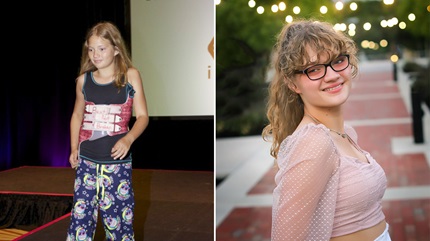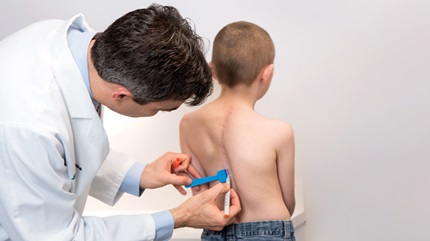Overview
Pediatric and adolescent scoliosis is an abnormal sideways curvature and rotation of the spine. About 2 to 3 percent of the U.S. population, or 7 million people, have this condition.
Scoliosis may be detected in infancy, childhood or adolescence. While this condition affects both girls and boys, girls are 10 times more likely than boys to need corrective surgery for it.
The thing to pay attention to is whether or not scoliosis progresses. Curves that are larger have a greater chance of progressing than smaller curves. However, even mild curvatures may worsen as a child’s spine grows.
Progression can lead to severe consequences in adulthood, including lung and heart problems and potential back pain. That’s why it is important to:
- Detect scoliosis as early as possible.
- Monitor its progress.
- Intervene when necessary.
Why Choose Us
For years, Cleveland Clinic has been providing comprehensive quality care for pediatric patients with acquired and congenital orthopaedic problems.
Our orthopaedic specialists are trained to treat conditions like scoliosis that are specific to children. Our children’s hospital and other surgical centers have pediatric anesthesiologists on staff who are adept at managing children’s anesthesia, and will provide general anesthesia for spine surgery.
Large centers like ours also have a neurological team to monitor spinal cord function minute-by-minute during the entire procedure. After surgery, pediatric anesthesiologists ensure that each child’s pain is well-controlled.
Free Treatment Guide
What We Treat
At Cleveland Clinic, we provide treatment for the three types of childhood scoliosis:
- Idiopathic scoliosis: Idiopathic scoliosis represents 80 percent of all cases of scoliosis. It usually develops during adolescence, between the ages of 10 and 16. Idiopathic means “of unknown cause” and scientists have not yet unraveled the reasons that scoliosis develops. But because idiopathic scoliosis runs in families, it has a genetic basis.
- Congenital scoliosis: Congenital, or infantile, scoliosis is a fairly rare bone abnormality detected at birth. Very often, it accompanies other birth defects, such as heart or kidney problems.
- Neuromuscular scoliosis: Neuromuscular scoliosis is caused by abnormalities in the muscles and nerves that support the spine. Thus, patients with muscular dystrophy, spina bifida and cerebral palsy are susceptible. Neuromuscular scoliosis can become quite severe.
Benefits
Multidisciplinary Approach
We bring together a team of highly trained specialists in order to determine the appropriate intervention and treatment plan for your child. Our pediatric scoliosis team includes:
- Pediatric orthopaedic surgeons.
- Pediatric anesthesiologists.
- Pediatric neurologists.
- Physiatrists.
- Radiologists.
- Physical and Occupational therapists.
Your child’s pediatrician is an integral member of our extended team with whom we consult in developing treatment and, when appropriate, ongoing care plans for your child.
Between our pediatric orthopaedic surgeons’ technical expertise and their involvement in ongoing research, we can offer your child the latest, most effective treatments.
Our Doctors
Other Providers
Appointments & Locations
To make an appointment with any of our scoliosis specialists, call toll-free 866.275.7496 or local 216.444.2606.
Virtual second opinion
If you cannot travel to Cleveland Clinic, help is available. You can connect with Cleveland Clinic specialists from any location in the world via a phone, tablet, or computer, eliminating the burden of travel time and other obstacles.
If you’re facing a significant medical condition or treatment such as surgery, this program provides virtual access to a Cleveland Clinic physician who will review the diagnosis and treatment plan. Following a comprehensive evaluation of medical records and labs, you’ll receive an educational second opinion from an expert in their medical condition covering diagnosis, treatment options or alternatives as well as recommendations regarding future therapeutic considerations. You’ll also have the unique opportunity to speak with the physician expert directly to address questions or concerns.


